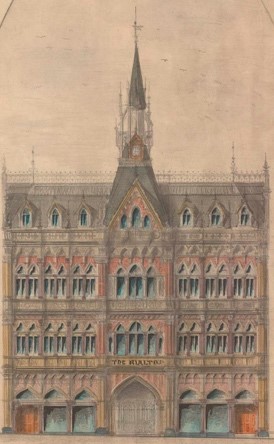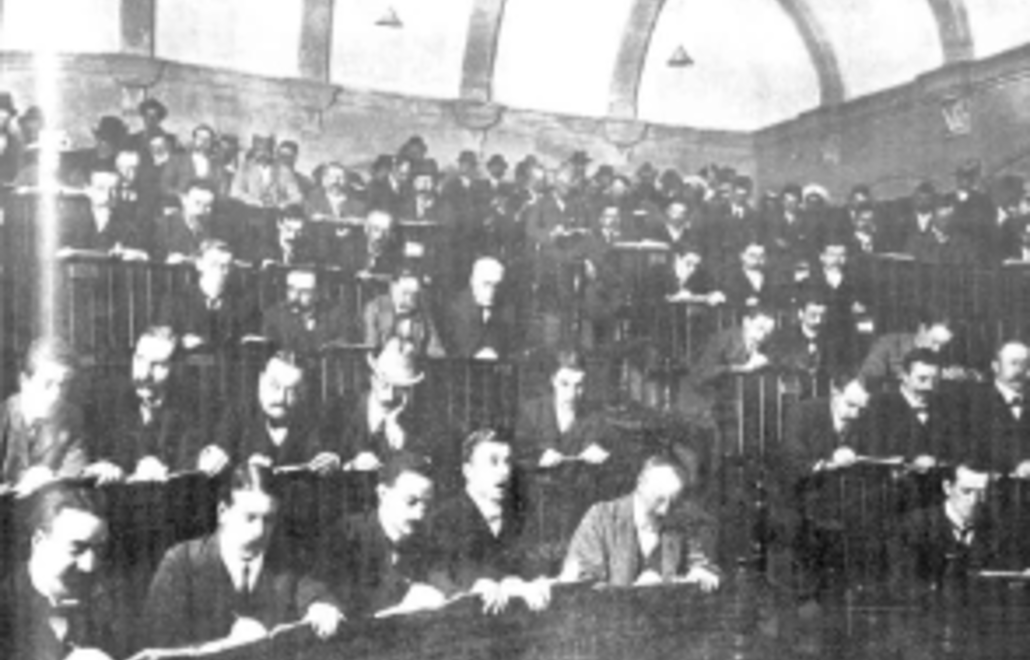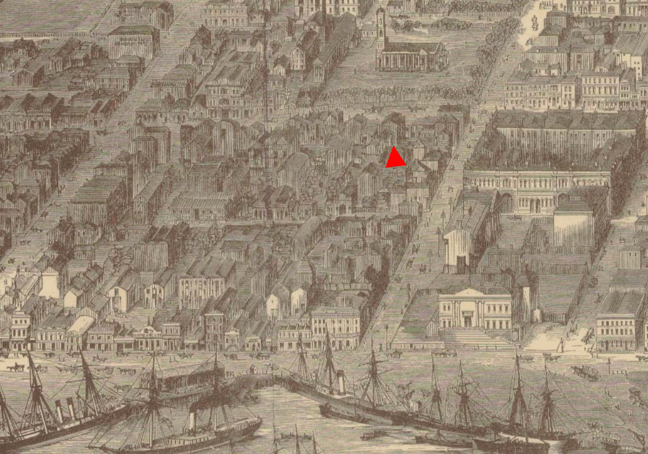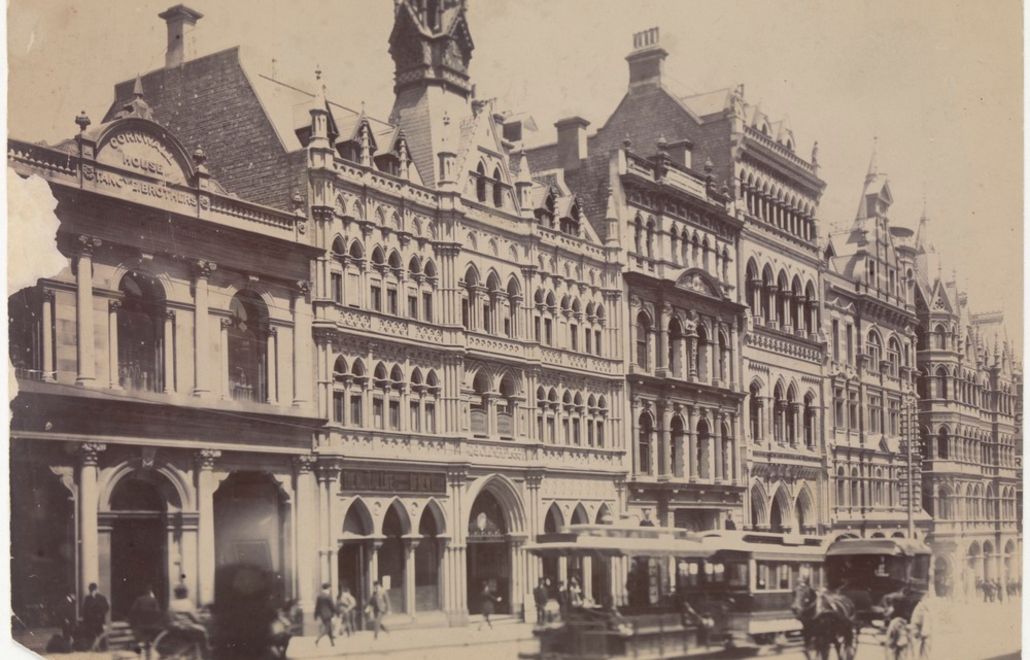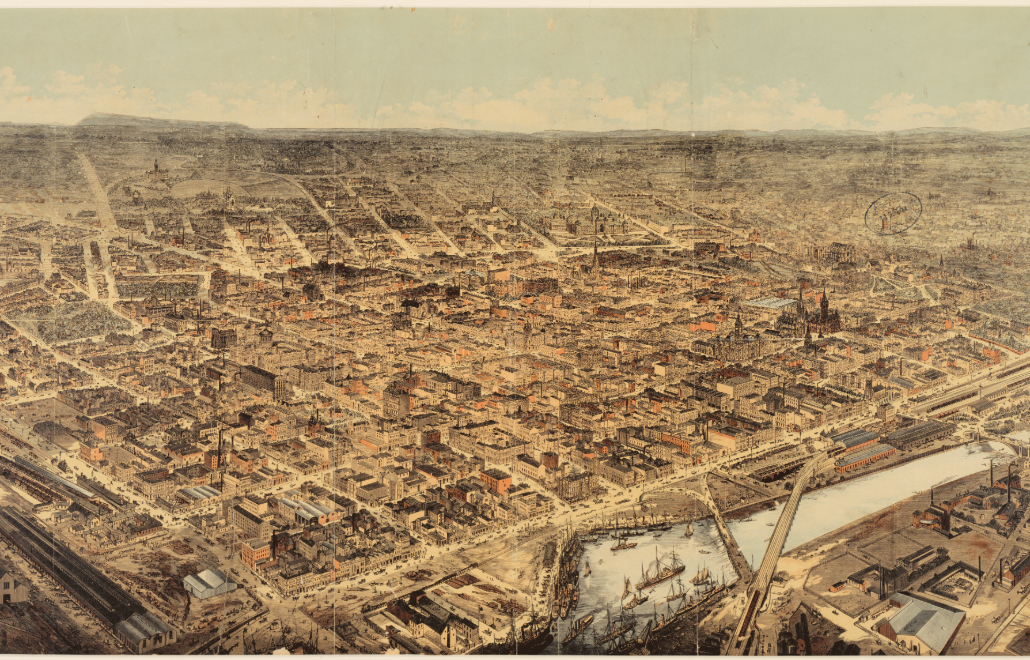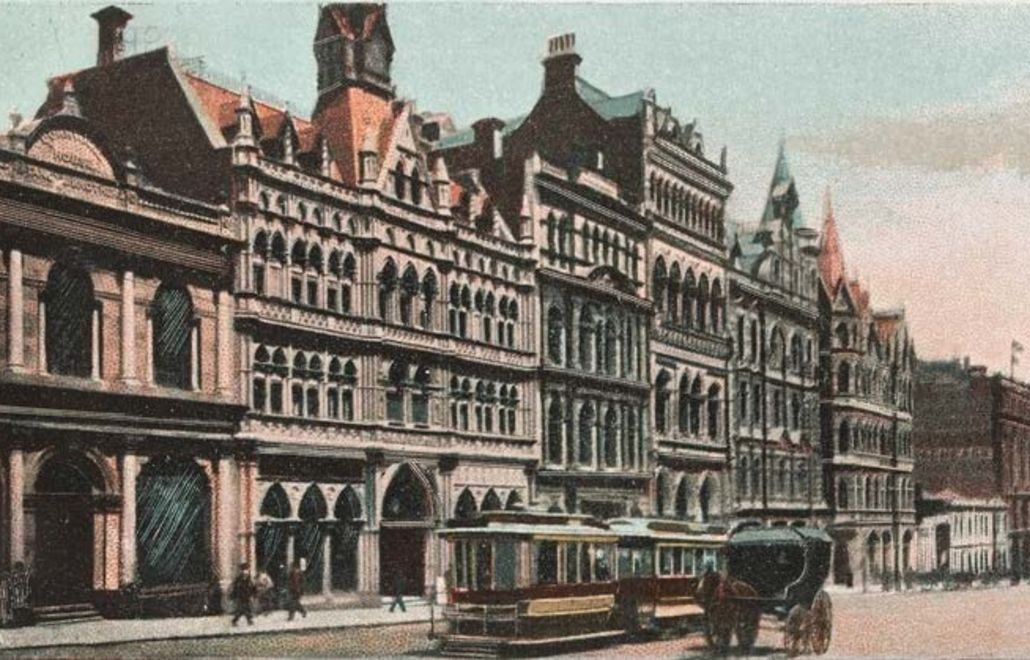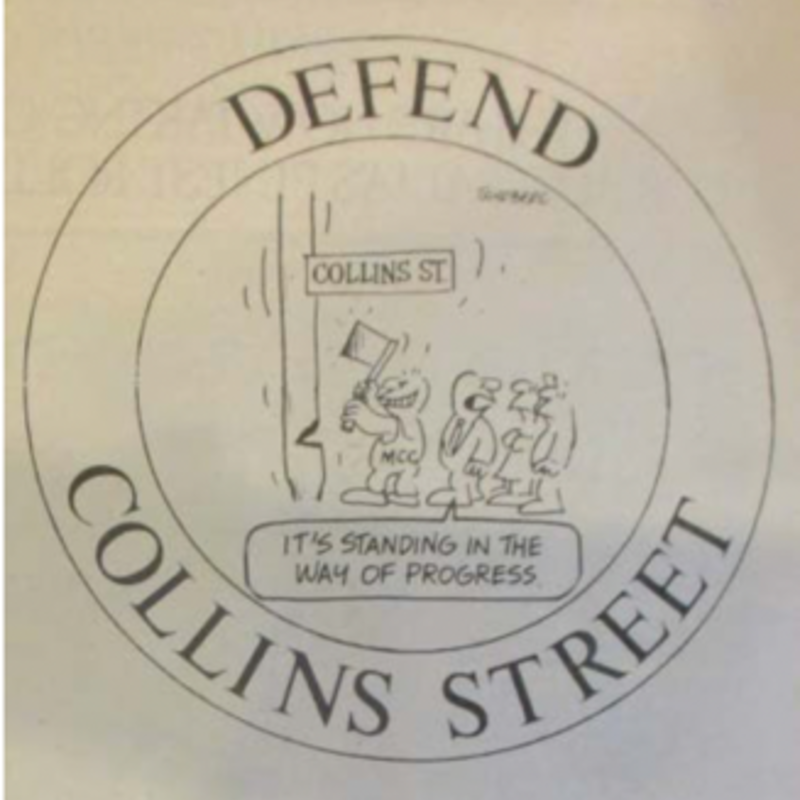Image: Sketch of Collins Street elevation of the Olderfleet building by William Pitt, May 1889
The Design
Pitt designed the building in the Venetian Gothic style, with a façade comprising three bays featuring a stunning Ruskinian encrusted façade with a striking central spire, a pinnacle Gothic Revival clock tower its crowning glory.
The Olderfleet building contributes to the striking Gothic streetscape of Collins Street, including the Rialto building and the Stock Exchange. The building was unique for its time as it focused on depth, rather than height. Of the three buildings, it contained the most modern offerings for its tenants, with around 30 offices on each floor, all of them connected to the telephone exchange. In fact, only minor changes were made to the original building in the hundred years that followed.
An 1890 report in the Argus described the recently completed Olderfleet:
‘Any ordinary passer-by in this locality will note the presence of a new building with an unusually handsome façade, and one of the first details observed will be the broad archway leading to the entrance-hall ... As regards the ornamental detail, there are foliated capitals, bosses, rosettes, spandrels, and other decorative devices in cement work, all harmonising well to suit the free style of the façade.’
The Olderfleet Clock quickly became an iconic fixture on Collins Street; the same Argus report waxed lyrical: ‘There are very pretty gables to this tower, which gives an exceedingly pleasant and appropriate finish to the building.’
Epicentre for Wool Trade
The sight and smell of wool defined Melbourne in the 1890s, with this global commodity bringing prosperity to the entire country as it was bought, sold and shipped around the world. With the Wool Exchange neighbouring the Olderfleet Building at 487 – 495 Collins Street (now the Winefield Building), and the Yarra River wharves a short walk away, the Olderfleet quickly became an epicentre for brokers and sellers conducting wool auctions and managing wool sales rooms.
Collins Street was a buzzing hub for important figures in the wool industry to socialise and network, with the Melbourne Woolbrokers Association residing in the Olderfleet Building in 1900.
It was only when a new wool exchange was constructed in King Street some fourteen years later that the number of wool brokers at Olderfleet began to decrease and a broader range of agricultural agents took their place.
Reinventing the Business Lounge
Powered by Work Club, enjoy additional meeting rooms and work spaces that act as a 'pressure release' to accommodate project teams and rapid growth within your business. This will include a new take on the executive club, promoting collaboration and '3rd space' innovation. Be captivated by the exhilarating, yet genuine, character of Work Club Olderfleet and come home to a strong sense of community and simply brilliant contemporary design. For bookings contact the concierge, or email melbourne.olderfleet@workclubglobal.com.
The Olderfleet Wellness Centre
Ashley Faithfull Training Studio is a new level of health and wellness studios merging premium services and luxury facilities.
Their boutique Olderfleet studio will provide the highest level of Personal Training, Yoga, corporate and small group training as well as health and wellbeing workshops and seminars. With a range of memberships on offer. Contact Ashley Faithfull on 0449 559 859 or ashley@aftrainingstudios.com.au to discuss available options and find out more about what this fantastic facility has to offer.
Childcare
On-site childcare will support work-life balance, offer convenience and help drive productivity.
End-of-Trip
Olderfleet's end-of-trip facility will enable a seamless transition between work and life. Bike parking, lockers, a premium towel service, showers, hair straighteners and dryers; Amenities to truly to optimise daily life.
Concierge Services
Olderfleet's premium concierge services will offer taxi and chauffeur services, restaurant reservations, flowers and gifts, VIP arrivals, ticket bookings and dry cleaning. An exceptional experience for all.
The missing clock
For 90 years, the Olderfleet Clock faithfully watched over Collins Street, its iconic presence taken for granted by those who lived and worked in the area. That is, until 1985 when, in the face of the site’s redevelopment, the clock went missing. Comically, the clock soon began writing to The Age, congratulating itself on “escaping the possible fate of ending up on a developer’s living room wall,” and advising readers, “I will not be returning.”
Becton, the site’s developer, beseeched the clock, also writing to The Age, “Please come back. The building won’t be the same without you.”
Following negotiations with the Historic Buildings Council, the Olderfleet building was beautifully restored in 1985, the Olderfleet Clock returned to its rightful place once more.
In a letter to The Age, titled ‘My life on the run’, the charismatic clock wrote to the developer one last time, offering its blessing to the Olderfleet building:
“My life on the run made me suspicious of every stranger, every knock on the door, and every idle construction worker…Good people of Melbourne, it is now obvious that certain developers can work in conjunction with the HBC and provide for both their own and the council’s interest. Nowhere is such a harmonious building more obvious than the Olderfleet complex in Collins Street.”
The Collins Street Defense Movement
In post-war era in Melbourne, the character of the city was changing, with taller office towers constructed in the CBD, particularly in the western end of Collins Street due to growing demand for modern workplaces.
All three buildings were owned by Hammerson Group, who wanted to develop the whole site. A community-led campaign, which the National Trust spear headed, called the Collins Street Defence Movement came out against the demolition of the buildings. The initial focus was on the Olderfleet building, which eventually led to the retention of the front portions of all three buildings during the 1980s.
In 1978, the Trust published the Collins Street Report, a comprehensive survey of buildings of the street, with recommendations for height controls and setbacks. In the report, the Trust collectively calls the buildings ‘The Olderfleet Place buildings’. They were central to the report, used as the cover image for the publication. The movement lead to the introduction of the first state heritage legislation, known as the Historic Buildings Act, which has been instrumental in upholding the significant history of Australia’s architectural movement.

